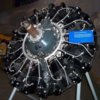I have even been known to use the edge of a steel rule - bit of a misuse of tools but it works

I tried that, and though it gets the edges off (which are of course raised a bit due to capillary action of the liquid resin in the mould) I couldn’t really get beyond that because the engine is very difficult to hold while scraping the back with a steel rule. Still, this made the edges flatter so they’ll fit more easily to replacement supports if I take out the inner wall

Having built a good few aircraft with a heap of resin cockpits and seats, I too am wondering about my sanity along with that of the people that produce these sets.
Same

I normally don’t overly bother with detailing cockpits, since little of it will be visible anyway, but for this one I decided to splash out. TBH, I think I would rather have added a bit of detail to the
Tamiya parts using the photos of the real cockpit I linked to earlier.
As good as the it looks when done, you close up the fuselage and think, (well I do), that was a wast of time.
And same here too. That’s why I don’t see the point at all for the 1:72 scale aircraft I usually build, but this being 1:48 I thought I’d give it a try. I probably won’t in future, if I build one in this scale again.
Seeing this I can see why I stick to tanks at least I have mud to help.
Luckily, AFVs are my main area too

There seems to be no quality standards to adhere to for model manufacturer's, I get the impression that " near enough " will do from a lot of these smaller aftermarket suppliers .
I have no other experience with cockpit sets, but this is a new experience in resin for me in that it’s both well-executed (good detail, quality casting) and poorly done (fragile parts, unclear instructions and locations) at the same time. Most resin kits or sets I’ve used over the years have either been good or poor overall, not both at the same time.
 Advanced modeller syndrome, really … Once that cockpit is done, the rest of the plane should be a quick and easy job, I think.
Advanced modeller syndrome, really … Once that cockpit is done, the rest of the plane should be a quick and easy job, I think.




